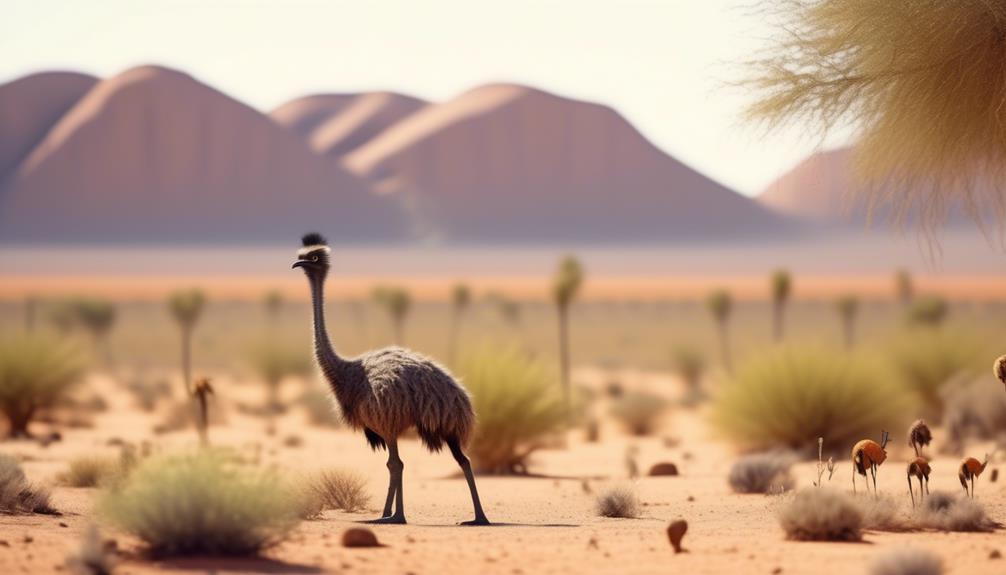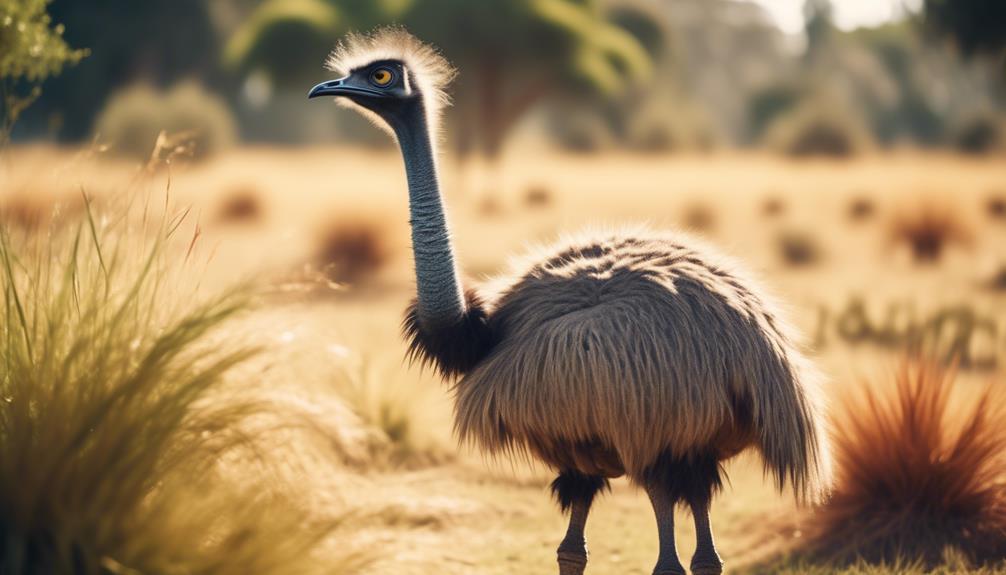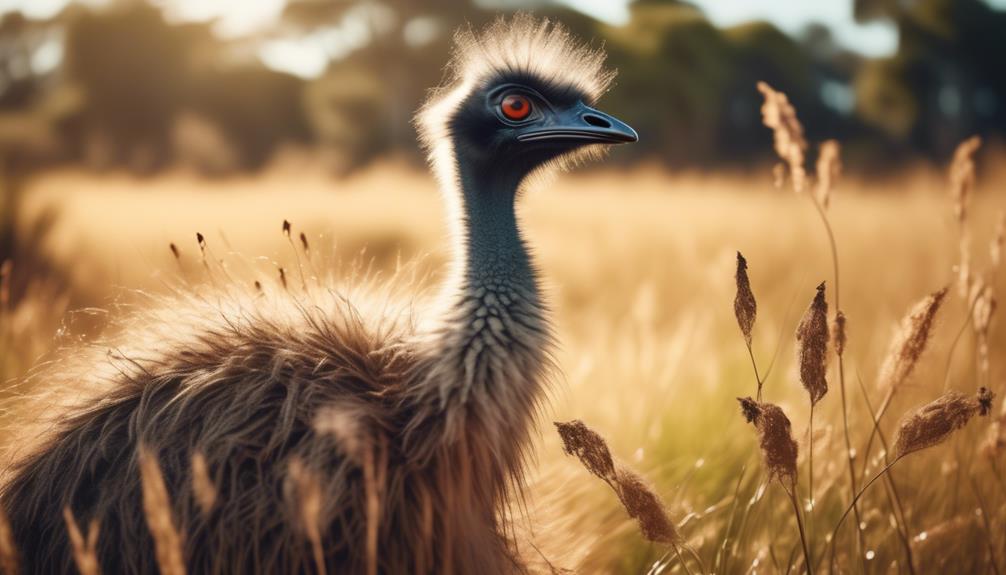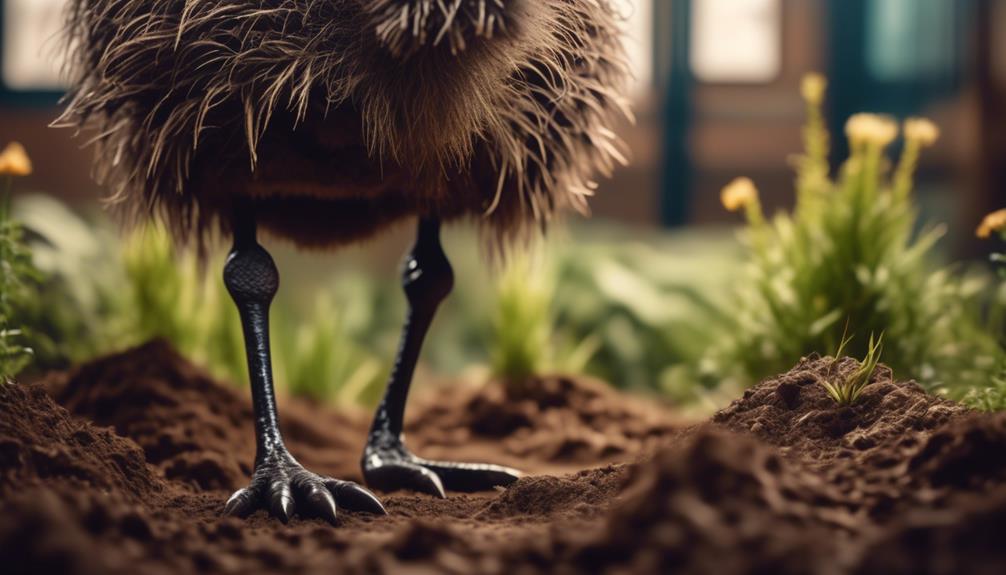
Curious about the emu's role in the intricate web of life? You may be intrigued to explore the fascinating connections this enigmatic creature has in the food chain.
From its unique diet to its impact on vegetation and predators, the emu's place in the ecosystem is far from ordinary. But that's just the beginning.
As you delve into the intricacies of its relationships with other herbivores, its role in seed dispersal, and even its influence on soil health, you'll gain a deeper understanding of the emu's significance in the natural world.
So, let's embark on this journey together and unravel the mysteries surrounding the emu's place in the food chain.
Key Takeaways
- Emus play a crucial role in herbivory and vegetation management. They help control the growth and spread of vegetation, prevent certain plants from dominating the ecosystem, and maintain a diverse plant community.
- Emus have interactions with predators and carnivorous animals, such as dingoes and eagles, which drive the evolution of defensive behaviors in emus. Understanding these interactions is important for protecting emus and maintaining ecosystem balance.
- Emus exhibit unique behaviors during reproduction, including polygynous mating, elaborate courtship displays, and male incubation of eggs. Assessing emu population dynamics and reproductive success is crucial for understanding their ecological impact and ensuring their survival.
- Emus make significant ecological contributions, such as regulating insect and invertebrate populations, aiding in seed dispersal and scarification, influencing nutrient cycling and microbial communities in the soil, and forming symbiotic relationships with other herbivores. Conservation efforts should focus on protecting their reproductive success, nesting habitats, and ecological contributions.
Emu's Diet
The Emu's diet consists of a variety of plant matter, making it an herbivorous bird. This unique foraging behavior contributes to the Emu's impact on ecosystem dynamics. As an herbivore, the Emu plays a crucial role in maintaining the balance of plant populations and nutrient cycling within its habitat. By consuming a wide range of plant species, including grasses, seeds, fruits, and leaves, the Emu helps control the growth and spread of vegetation.
Through its feeding habits, the Emu influences the structure and composition of plant communities. It can selectively consume certain plant species, which can lead to changes in the abundance and distribution of those plants. Additionally, the Emu's foraging behavior can impact the availability of resources for other herbivores, such as kangaroos and wallabies, as they often share the same habitat.
Furthermore, the Emu's diet affects nutrient cycling within the ecosystem. As the bird consumes plant matter, it digests and excretes waste, returning nutrients to the soil in a bioavailable form. This process contributes to the fertility of the land, allowing for the growth of new vegetation.
Role in Herbivory
Emus play a significant role in herbivory within their ecosystem through their selective consumption of plant species. Their grazing behavior allows them to shape the composition and structure of the vegetation in their environment, influencing the overall dynamics of the ecosystem. As herbivores, emus have evolved to occupy a specific ecological niche where they primarily feed on grasses, shrubs, and other plant materials.
Emus are known for their ability to selectively choose the plant species they consume. This selective feeding behavior is crucial in maintaining a diverse plant community. By focusing on certain plant species, emus control the abundance of these plants, preventing them from dominating the ecosystem and allowing other plant species to flourish. This helps to maintain a balanced and diverse ecosystem.
Their grazing behavior also has implications for nutrient cycling within the ecosystem. As emus consume plants, they break down organic matter and release nutrients back into the soil through their droppings. This nutrient cycling process contributes to the overall fertility of the soil, supporting the growth and vitality of the surrounding vegetation.
Impact on Vegetation

Through their selective consumption of plant species, emus exert a profound influence on the vegetation within their ecosystem, shaping its composition and dynamics. Emus play a crucial role in maintaining the balance of the ecosystem by affecting the distribution and abundance of different plant species. Their feeding habits have both direct and indirect effects on plant diversity, ultimately impacting the overall health and function of the ecosystem.
Emus have a unique feeding behavior that involves selectively consuming certain plant species while avoiding others. This selective consumption can lead to changes in the composition of plant communities. By preferentially consuming certain plants, emus help control their population and prevent them from dominating the ecosystem. This promotes a more diverse plant community, which in turn supports a greater variety of other organisms.
To illustrate the impact of emus on vegetation, let's consider a table that showcases some plant species commonly consumed by emus and their corresponding effects on the ecosystem:
| Plant Species | Emu's Consumption | Effect on Ecosystem |
|---|---|---|
| Grasses | High | Controls grass dominance |
| Shrubs | Low | Encourages shrub growth |
| Seeds | Moderate | Seed dispersal |
| Succulents | High | Creates microhabitats |
| Forbs | Low | Promotes forb diversity |
Predators of Emus
Predators pose a significant threat to the survival of emus in their natural habitat. These majestic flightless birds, known for their size and speed, have evolved various adaptations to protect themselves from predators. However, their vulnerability to certain predators remains a concern.
Emus are targeted by a range of predators, including:
- Dingoes: These wild dogs are skilled hunters and have been known to prey on emus, particularly the young ones.
- Eagles: Large raptors such as wedge-tailed eagles pose a threat to emus, especially to their eggs and young chicks.
- Humans: While not natural predators, human interactions with emus can sometimes result in their death, either intentionally or unintentionally.
Emus have a unique social behavior that can impact their interactions with predators. They often form small groups or pairs, with an alpha male leading the group. This social structure allows them to communicate and coordinate, enhancing their chances of survival. When faced with a predator, emus will adopt defensive behaviors such as erecting their feathers and emitting low-frequency booming sounds to intimidate their foe. They can also run at remarkable speeds, reaching up to 30 miles per hour, to escape from predators.
Understanding the predators of emus is crucial for their conservation. By studying their interactions with humans and their social behavior, we can better protect these magnificent creatures and ensure their continued presence in our natural ecosystems.
Interactions With Carnivores

The interaction between emus and carnivores plays a crucial role in shaping the survival strategies and behaviors of these magnificent flightless birds. Emus, being herbivores themselves, have limited interactions with carnivorous animals. Nevertheless, these interactions are important for maintaining the delicate balance of the ecosystem.
Emus are occasionally targeted by scavengers such as dingoes, foxes, and feral cats. While emus possess strong legs and can defend themselves against some predators, they can still fall victim to these opportunistic carnivores. This interaction between emus and scavengers serves as a natural selection pressure, driving the evolution of defensive behaviors and strategies in emus.
To evoke emotion and provide a visual representation, consider the following table:
| Carnivores | Interactions with Emus | Impact on Emu Population |
|---|---|---|
| Dingoes | Predation | Decrease |
| Foxes | Predation | Decrease |
| Feral Cats | Predation | Decrease |
This table underscores the vulnerability of emus to carnivores and their potential impact on the emu population. By understanding these interactions, we can better appreciate the challenges faced by emus and the delicate balance required for their survival in the ecosystem.
Emu's Reproduction and Population Dynamics
During the reproductive process, emus exhibit unique behaviors and population dynamics that contribute to their overall survival and ecological impact. Understanding the emu's mating behavior and reproductive success is crucial for assessing the health and stability of their population.
- Emu's Mating Behavior:
- Emus are polygynous, meaning that males mate with multiple females during the breeding season.
- Males attract females by making deep booming sounds and performing elaborate courtship displays, such as puffing out their chests and swaying their bodies.
- Once a male has attracted a female, they form a pair bond and engage in a complex mating ritual that involves vocalizations and physical displays.
- Emu's Reproductive Success:
- Female emus lay large, green eggs in communal nests constructed by the males.
- After laying her eggs, the female leaves the nest and the male takes sole responsibility for incubating the eggs and raising the chicks.
- Emus have high reproductive success rates, with most eggs hatching successfully and a high survival rate for the chicks.
Understanding these aspects of emu reproduction provides insight into their population dynamics and helps us monitor their numbers. By ensuring the success of their reproductive process, we can contribute to the conservation of these magnificent birds and maintain their vital role in the ecosystem.
Influence on Insect and Invertebrate Populations

Emus play a significant role in regulating insect and invertebrate populations within their ecosystem. Their foraging behavior and dietary preferences have a direct impact on insect population dynamics and invertebrate biodiversity. By consuming a variety of insects and invertebrates, emus help control their population sizes and prevent outbreaks that can disrupt the balance of the ecosystem.
To better understand the influence of emus on insect and invertebrate populations, let's take a closer look at the table below:
| Insect/Invertebrate | Emu's Impact | Result |
|---|---|---|
| Grasshoppers | Emus feed on grasshoppers, reducing their population | Control of grasshopper outbreaks |
| Beetles | Emus consume beetles, decreasing their numbers | Prevention of beetle infestations |
| Snails | Emus eat snails, reducing their population | Minimization of snail damage to plants |
As emus regulate the populations of these insects and invertebrates, they help maintain the overall balance of their ecosystem. By preventing outbreaks and infestations, emus contribute to the health and stability of the environment, ensuring the survival of both plant and animal species.
Emus' influence on insect and invertebrate populations demonstrates their crucial role in the food chain. Their foraging behavior not only satisfies their own dietary needs but also contributes to the overall ecosystem health. With their impact on insect population dynamics and invertebrate biodiversity, emus play a vital role in maintaining the delicate balance of their habitat.
Emu's Role in Seed Dispersal
Continuing our exploration of the impact of emus on their ecosystem, let's now examine the crucial role these birds play in the dispersal of seeds.
Emus, with their large size and strong legs, have a significant impact on the ecosystem by aiding in the dispersal of seeds. Here are three key ways in which emus contribute to the biodiversity of their habitat:
- Seed Consumption: Emus consume a wide variety of fruits and seeds as part of their diet. These seeds pass through the emu's digestive system relatively intact and are then excreted in different locations, facilitating their dispersal to new areas.
- Seed Transportation: Emus are known to travel long distances in search of food and water. During their journeys, they inadvertently carry seeds on their feathers and feet. As they move from one place to another, these seeds are dislodged, allowing for the colonization of new areas.
- Seed Scarification: Emus have a unique way of assisting in seed germination. The seeds they consume often have hard outer coatings that can be difficult to penetrate. However, as the seeds pass through the emu's digestive system, the acid and mechanical action help to scarify the seeds, making them more susceptible to germination.
The emu's role in the ecosystem and its impact on biodiversity can't be overstated. By dispersing seeds through consumption, transportation, and scarification, emus contribute to the establishment and survival of various plant species, ensuring the continued health and diversity of their habitat.
Emu's Impact on Soil Health

The impact of emus on soil health is a significant aspect to consider when examining their role in the ecosystem. Emus play a crucial role in nutrient cycling and have a profound effect on microbial communities in the soil. Understanding these influences is essential for maintaining a healthy and balanced environment.
Emus, as large flightless birds, have a unique feeding behavior that involves scratching and digging the ground with their powerful feet. This action not only helps them search for food but also has a direct impact on the soil. The table below illustrates the various ways emus influence nutrient cycling and affect microbial communities in the soil.
| Emu's Influence on Nutrient Cycling | Emu's Effect on Microbial Communities |
|---|---|
| Emus consume plant material and excrete nutrient-rich droppings, enhancing nutrient availability in the soil. | Emus disturb the soil, promoting the growth of beneficial microbial communities. |
| Emus consume seeds, which can reduce competition among plants and allow for the establishment of new species. | Emu activity increases soil aeration, facilitating the growth of soil-dwelling microorganisms. |
| Emus break up compacted soil with their scratching behavior, improving water infiltration and nutrient absorption. | Emu droppings provide a food source for soil microbes, stimulating their growth and activity. |
| Emus consume insects and small animals, which helps control pest populations and promote a balanced soil ecosystem. | Emu foraging behavior introduces organic matter into the soil, enriching it and supporting microbial diversity. |
Emu's Relationship With Other Herbivores
Considering the significant impact emus have on soil health, it's important to explore their relationship with other herbivores in order to fully understand their role in the ecosystem.
• Emu's social behavior: Emus are highly social birds, forming small groups or pairs for mating and nesting purposes. They communicate through a range of vocalizations and body language, establishing hierarchies within their groups. This social behavior allows emus to form symbiotic relationships with other herbivores, sharing information about food sources and potential threats.
• Emu's environmental adaptations: Emus have evolved several adaptations that enable them to thrive in their environment. Their long legs and powerful feet allow them to cover large distances, making them efficient grazers. They've a unique digestive system that enables them to extract maximum nutrients from the vegetation they consume. Additionally, their feathers provide insulation, helping them regulate body temperature in extreme weather conditions.
Emus interact with other herbivores in various ways. They often graze alongside kangaroos and wallabies, benefiting from their ability to locate food sources. Their large size and powerful kick act as a deterrent against potential predators, providing protection not only for themselves but also for their herbivore companions. This interdependence between emus and other herbivores highlights the intricate web of relationships within the ecosystem, where each species plays a vital role in maintaining the balance of nature.
Conservation Efforts for Emu Protection

Efforts to conserve and protect emus have been implemented to ensure the survival of this iconic species. Conservation strategies aim to address the main threats faced by emus, such as habitat loss and fragmentation. Habitat preservation plays a crucial role in maintaining viable populations of emus. Emus rely on a diverse range of habitats, including grasslands, savannas, and woodlands, for feeding, nesting, and breeding.
To protect their habitats, conservation organizations and government agencies work together to establish protected areas, implement land-use planning, and promote sustainable agricultural practices.
Conservation efforts also involve monitoring and managing emu populations. Researchers conduct population surveys and collect data on breeding success, mortality rates, and habitat quality. This information helps identify areas in need of conservation intervention and guides the development of management plans. Effective management may include predator control, habitat restoration, and translocation programs.
In addition, education and public awareness campaigns play a vital role in emu conservation. By raising awareness about the importance of emus and their habitats, these campaigns encourage public support and engagement in conservation efforts. They also aim to reduce human-wildlife conflicts and promote responsible behaviors, such as avoiding disturbance to nesting sites and reporting injured or orphaned emus.
Frequently Asked Questions
How Fast Can Emus Run and How Does Their Speed Help Them in Their Role as Herbivores?
Emus can sprint up to 30 miles per hour, a speed which aids them in their role as herbivores. Their swift running enables them to escape predators, forage efficiently, and disperse seeds, impacting ecosystem dynamics.
Do Emus Have Any Natural Defenses Against Their Predators?
Emus, as prey animals, have developed natural defenses to avoid predators. These defenses include their impressive speed and agility, powerful kicks, and ability to camouflage in their environment. These adaptations greatly increase their chances of survival.
Are There Any Specific Plants or Vegetation That Emus Prefer to Eat Over Others?
Emus have specific preferences when it comes to their diet. They select certain plants and vegetation over others, which can have an impact on the diversity of vegetation in their environment.
How Do Emus Affect the Population Dynamics of Other Herbivores in Their Ecosystem?
Emus' impact on other herbivores and their role in ecosystem dynamics are fascinating subjects. They can influence population dynamics by competing for resources and altering vegetation, which in turn affects other herbivores' abundance and distribution.
What Are Some Potential Negative Impacts of Emus on Soil Health and How Can They Be Mitigated?
Soil degradation and erosion can occur as a result of emus' foraging behavior. To mitigate these negative impacts, you can implement measures such as rotational grazing, reseeding, and erosion control practices to maintain soil health.
Conclusion
In conclusion, the emu plays a crucial role in the food chain as a herbivore, contributing to seed dispersal and impacting vegetation and soil health.
Interestingly, emus are known to consume up to 2.5 kilograms of vegetation per day, making them a significant force in shaping their ecosystem.
Conservation efforts should be prioritized to protect the emu and maintain the balance of the food chain.
By understanding their place in the ecosystem, we can ensure the long-term sustainability of these unique birds.




